Designs
Quality and Design
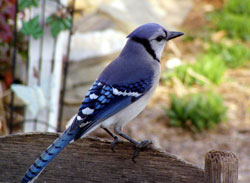 If you could graph the quality/price
ratio, you would find that quality increases proportionately with price
until the very top of the line where price goes up sharply for that last
little bit of features. High-quality optics have multi-element lenses
with several coatings to optimize the visible light spectrum, very close
tolerance manufacturing processes and the best optical supports, consistency,
and alignments available. To get optimum performance, durability and consistency,
there is no way around the expense to produce the best.
If you could graph the quality/price
ratio, you would find that quality increases proportionately with price
until the very top of the line where price goes up sharply for that last
little bit of features. High-quality optics have multi-element lenses
with several coatings to optimize the visible light spectrum, very close
tolerance manufacturing processes and the best optical supports, consistency,
and alignments available. To get optimum performance, durability and consistency,
there is no way around the expense to produce the best.
On the other hand, middle price
range optics ($400-$700) in today’s market can be very fine instruments.
The optics in this category are really making great strides. If price
is a major consideration, several of the mid-range optics may not have
quite as many elements (both objective and eye piece), features, and options
but are still fine optics with only slight differences in viewing ability
under most situations.
That said, especially in low-light
conditions, you truly do get what you pay for in optics. Birders who are
demanding of their optics will want the best they can afford. High-quality
optics perform well in all conditions, deliver the sharpest image with
the truest colors and have ergonomic designs that maximize comfort during
use. Even with the best optics, there are many considerations and choices.
There are also some trade-offs that will be determined by each individual's
needs and wants. There is no ideal design or "star wars" pair of binoculars
on the market, and the optics you choose is best determined by what you
want from them, the conditions under which you will be using them and
what you can afford.
Porro and Roof Prism Designs
In modern binoculars and spotting
scopes there are two main designs. These are the porro and roof prism
designs as shown in Figure #1 and Figure #2 below. The
porro prism was the first of these two designs and consists of two mirrors
mounted separately. The roof prism is a more modern design that consists
of two prisms cemented together in a single interior mount. In both designs,
light passes through objective lenses that cast it onto a set of mirrors
that further flip, rotate and focus the image through an eyepiece and
into our eyes. The final view is brought into sharp focus with the focusing
knob that changes the distance between the mirrors and either the eyepiece
or objective lens. There may be as many as 10 pieces of glass in each
barrel that the light passes through before the final image reaches our
eyes (typically a minimum of 6).
|
(Figure #1)
|
(Figure #2)
|
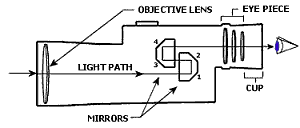
|
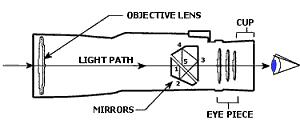
|
|
Porro Prism
|
Roof Prism
|
Quotes from Charles A. Bergman, Audubon, November 1981
Porro prism (see Figure #1 above)
"But how do binoculars present
an upright image to the viewer? ...An Italian named M. Porro invented
the first prismatic inverting system in the middle of the nineteenth century...Porro's
system consists of two identical prisms in each barrel of the binocular,
placed at right angles to each other. Each prism looks rather like one
of Napoleon's hats, the bicorne. Like mirrors, each prism reflects and
reverses the light off its steep sides. One prism reverts the image left
to right and the other prism inverts the image top to bottom. With an
acrobat's grace, the image somersaults through the binoculars, springing
to our eyes, normal and erect, a natural perspective."
Roof prism (see Figure #2 above)
"Roof prisms were invented
in the nineteenth century, in the optical workshop of Carl Zeiss at Jena,
Germany. A young professor of physics at the University of Jena, Ernst
Abbe, formulated the mathematical laws for the paths of light through
microscopes. Together with the chemist Otto Schott, he also invented the
first high-quality, reproducible optical glass. At age twenty-six, he
became director of research for Zeiss. Using his own mathematics and glass—both
historical contributions to the optical industry—Abbe created not only
the microscopes of Louis Pasteur, but also a pentaprism, the "Abbe roof
prism." Abbe's roof prism was the progenitor of a vast array of modern
roof prisms. Inside, roof prisms juggle the light rays through an invisible
labyrinth of angles, a convoluted path, a mathematical marvel. On the
outside, a roof-prism binocular is elegant in its simplicity."
Practical differences
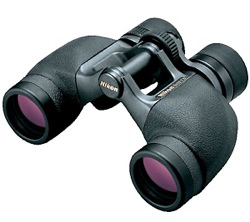 The differences in durability,
image and optical quality in binoculars and scopes are most pronounced
between lower and middle priced optics with less dramatic changes between
middle- and high-priced optics. The two types of optic designs reach peaks
in each of these factors at different price levels.
The differences in durability,
image and optical quality in binoculars and scopes are most pronounced
between lower and middle priced optics with less dramatic changes between
middle- and high-priced optics. The two types of optic designs reach peaks
in each of these factors at different price levels.
The only difference between
the two designs in full-sized binoculars that does not change with price
is their size and shape. Porro prisms are larger and more bulky than roof
prisms. Most bird watchers are inclined to stick with the slim roof prism
design although there are those with big hands that claim that the larger
porro prisms are more comfortable for them (I have large hands and do
not find this so).
Porro prism binoculars reach
very good optic quality at about $250. Roof prisms usually do not reach
an equivalent level of optical quality until about $400-$700. Roof prisms,
because of the engineering required, are more expensive than porro prisms
of equivalent optical quality. Modern roof prism binoculars tend to have
two separate prisms that are cemented together, rather than two offset
prisms of the porro prism design. Porro prism designs consequently tend
to be much more susceptible to alignment problems if dropped. This can
be very costly to fix. Thus, both weather resistance and durability are
better in roof prism binoculars.
Roof prism designs are almost
exclusively internal focusing and that makes them much easier to seal
and keep waterproof. Even expensive waterproof porro prism designs typically
are sealed with "o" rings and are not internal focusing. The mechanical
movements of the eyepiece (or objective) moving back and forth, and wear
on an "o" ring can cause problems over time. First is loss of the seal,
allowing moisture and dust into the interior. Moisture and dust settling
on the mirrors degrade the performance. Next, wearing of an "o" ring causes
focusing friction. As the "o" ring degrades, the focus becomes progressively
stiffer. The need for nitrogen (or other dry gas) fill and sealed optics
to prevent internal fogging and condensation are discussed in the weatherproof
section.
Reverse Porro Prism
| (Figure #3) |
(Figure #4) |
Not to confuse the previous
statements about the size and shape being the only constants that do not
change between porro and roof prism designs, we should mention reverse
porro prism binoculars. In the case of compact binoculars there is also
a reverse porro prism design. These are small, nice lightweight designs.
The difference is shown at the left.
|
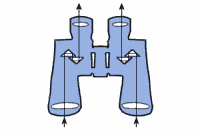 Regular Porro Prism
Regular Porro Prism |
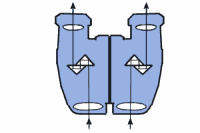 Reverse Porro Prism
Reverse Porro Prism |
Compact binoculars
Although we do not recommend
compact binoculars for primary use, they certainly do have their place.
These are smaller optics that generally range from 20-32 mm in objective
size and 6-10 power. The next article (Basics
II - Designations and Considerations) addresses issues such as magnification,
exit pupil, and objective diameter that are especially important considerations
when choosing compact binoculars.
Compact binoculars are appropriate
when full-size binoculars are too large to carry (such as while biking,
backpacking...), as extra binoculars left in a car glove box, or maybe
for small children. Especially with children, the choice of compacts deserves
careful consideration since they may be more difficult to use because
of a small exit pupil. Compact binoculars have the advantages of smaller
size and reduced cost.
All issues considered in choosing
full-size binoculars also hold true when choosing a pair of compact binoculars.
Weight is less of a consideration but magnification becomes a greater
consideration since small binoculars have a smaller objective lens. They
can even be more difficult to hold steady and the smaller objective lenses
transmit less light.
As you read the following article
discussing the choices and options that make for a good pair of binoculars,
the cautions and considerations above apply to this choice. The only unique
choice is in the reverse porro prism. Reverse porro prism designs are
generally confined to compact binoculars because as the objective diameters
become larger the distance between the eyepieces becomes prohibitively
great.>
Design Conclusions
- Both porro and roof prism binoculars can deliver excellent
optical quality.
- Neither is inherently lighter or easier to use for any
individual.
- Optical quality comes at a cheaper price with porro
prisms.
- Slender design and durability is better associated with
roof prisms.
- Top of the line optics in either design are comparable
in all aspects, including price.
Previous Article - Introduction
| Next Article - Basics II